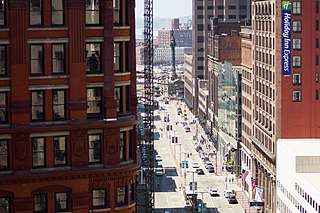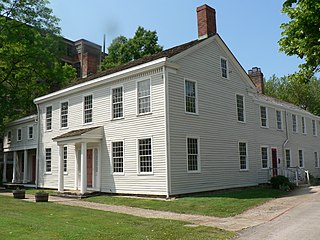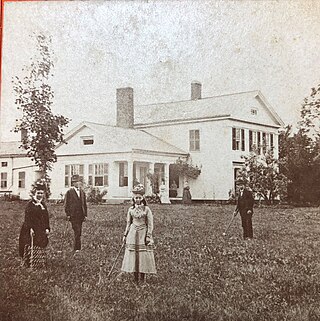
Cleveland, officially the City of Cleveland, is a city in the U.S. state of Ohio and the county seat of Cuyahoga County. Located in the northeastern part of the state, it is situated along the southern shore of Lake Erie, across the U.S. maritime border with Canada, 252 miles (406 km) northeast of Cincinnati, 143 miles (230 km) northeast of Columbus, and approximately 60 miles (97 km) west of Pennsylvania.

Cuyahoga County is a large urban county located in the northeastern part of the U.S. state of Ohio. It is situated on the southern shore of Lake Erie, across the U.S.-Canada maritime border. As of the 2020 census, its population was 1,264,817, making it the second-most-populous county in the state.

Canfield is a city in central Mahoning County, Ohio, United States. The population was 7,699 as of the 2020 census. A suburb about 8 miles (13 km) southwest of Youngstown, the city lies at the intersection of U.S. Routes 62 and 224 and is part of the Youngstown–Warren metropolitan area. In 2005, Canfield was rated the 82nd best place to live in the United States by Money magazine.

The Connecticut Western Reserve was a portion of land claimed by the Colony of Connecticut and later by the state of Connecticut in what is now mostly the northeastern region of Ohio. The Reserve had been granted to the Colony under the terms of its charter by King Charles II.

Bath Township is one of the nine townships of Summit County, Ohio, United States. The 2000 census found 9,635 people in the township, a suburb of Akron.

Euclid Avenue is a major street in Cleveland, Ohio. It runs northeasterly from Public Square in Downtown Cleveland, passing Playhouse Square and Cleveland State University, to University Circle, the Cleveland Clinic, Severance Hall, Case Western Reserve University's Maltz Performing Arts Center, Case Western Reserve University and University Hospitals Case Medical Center. The street runs through the suburbs of East Cleveland, Euclid, and Wickliffe, to Willoughby as a part of U.S. Route 20 and U.S. Route 6. The HealthLine bus rapid transit line runs in designated bus lanes in the median of Euclid Avenue from Public Square to Louis Stokes Station at Windermere in East Cleveland.

University Circle is a district in the neighborhood of University on the East Side of Cleveland, Ohio. One of America's densest concentrations of cultural attractions and performing arts venues, it includes such world-class institutions as the Cleveland Museum of Art; Severance Hall ; the Cleveland Institute of Art; Case Western Reserve University; the Cleveland Institute of Music; the Museum of Contemporary Art Cleveland; the Cleveland Botanical Garden; historic Lake View Cemetery; the Cleveland Museum of Natural History; and University Hospitals/Case Medical Center.

Hale Farm and Village is a historic property of the Western Reserve Historical Society in Bath Township, Summit County, Ohio, United States. It is within the boundaries of the Cuyahoga Valley National Park. Hale Farm was the original homestead of Jonathan Hale, a Connecticut farmer who migrated to the Western Reserve in 1810. In 1973 Hale Farm was listed on the National Register of Historic Places as the Jonathan Hale Homestead. The Hale House was built in 1825.

Downtown Cleveland is the central business district of Cleveland, Ohio. The economic and symbolic center of the city and the Cleveland-Akron-Canton, OH Combined Statistical Area, it is Cleveland's oldest district, with its Public Square laid out by city founder General Moses Cleaveland in 1796.

Euclid Beach Park was an amusement park located on the southern shore of Lake Erie in the Collinwood neighborhood of Cleveland, Ohio, which operated from 1895 to 1969.

James A. Garfield National Historic Site is a United States National Historic Site located in Mentor, Ohio. The site preserves the Lawnfield estate and surrounding property of James Abram Garfield, the 20th president of the United States, and includes the first presidential library established in the United States.

The Dunham Tavern, also known as the Dunham Tavern Museum, is the oldest building in Cleveland, Ohio, located at 6709 Euclid Avenue. Rufus and Jane Pratt Dunham built their first home on the site in 1824, and the existing taproom was built in 1842. It is believed to be the first building constructed on Euclid Avenue east of East 55th Street and the first frame house on the street. It later became a stagecoach stop and tavern.

Cuyahoga County, Ohio, United States is divided into 21 townships.

This is a list of the National Register of Historic Places listings in Cleveland, Ohio.

Mather House, formally named Flora Mather House, is a college building named for Flora Stone Mather at Case Western Reserve University in Cleveland, Ohio. It was built as a dormitory for the Flora Stone Mather College for Women of Western Reserve University, and currently houses classrooms and offices for the university's departments of art history, classics, history, and political science.

This article is a timeline of the history of the city of Cleveland, Ohio, USA.

Abram Garfield was the youngest son of President James A. Garfield and Lucretia Rudolph Garfield, and an architect who practiced in Cleveland, Ohio.

James Hotchkiss Rogers was an American organist, composer, teacher, music critic, and publisher.

Hinman B. Hurlbut was an American industrialist. A native of New York, Hurlbut relocated to Cleveland, Ohio, in 1837 and started a career privately practicing law in Massillon, Ohio after being admitted to the bar in 1839. After a lucrative career as a lawyer, he found success as a business leader in Cleveland and came to own four national banks by 1863.

The Sawyer-Barrow House, first known as the Joseph Sawyer House, and then for 78 years as the summer estate Twin Maples, was built c. 1825 for Joseph Sawyer (1778-1849) by the Western Reserve's master builder Jonathan Goldsmith.





















